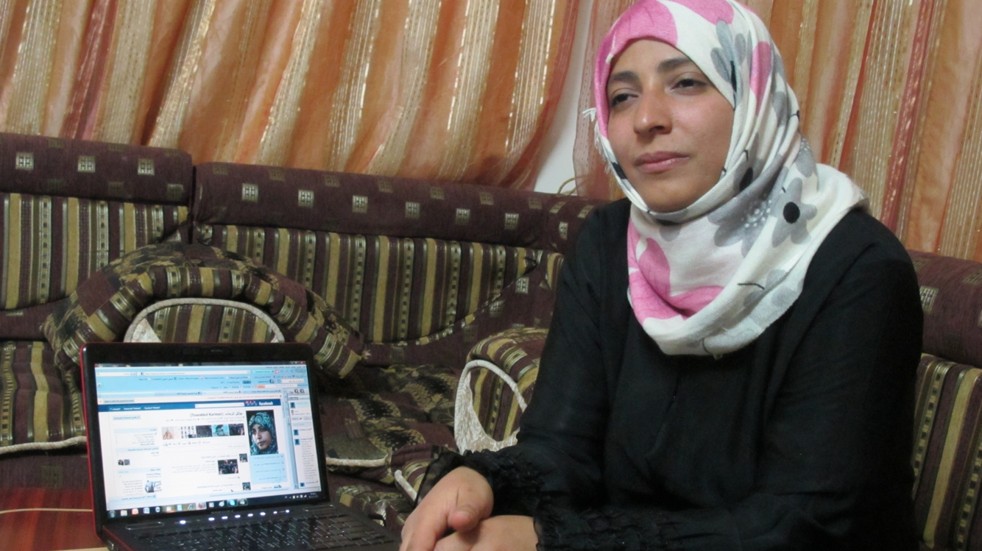The Real Net Effect: Can Social Media Make A Difference in Yemen? (Alwazir)
 Monday, January 2, 2012 at 9:15 |
Monday, January 2, 2012 at 9:15 |  Scott Lucas in
Scott Lucas in  EA Middle East and Turkey,
EA Middle East and Turkey,  Journalism and Media,
Journalism and Media,  Middle East and Iran
Middle East and Iran  Yemeni Activist Tawakkul KarmanAtiaf Alwazir writes for Al Akhbar:
Yemeni Activist Tawakkul KarmanAtiaf Alwazir writes for Al Akhbar:
A young group of men and women hover over their laptops while sipping expensive lattes at one of Sana’a’s four main Western style coffee shops. For the past six months, the majority of people in the Yemeni capital of Sana’a have received between two to four hours of electricity a day. Many of the customers are “electricity refugees” as activist Hamza Al-Sharjabi describes people who move from place to place in search of public spaces with generators for Internet and electricity.
Many activists are also at the cafes, often carrying with them heavy backpacks with their laptops and the chargers needed to power their camera, laptop, and phones.
One of these cafés is located about 1 kilometer from an entrance to the square, making it a proper spot for activists to meet, charge their equipment, update their blog, tweet, or go on Facebook via the terribly slow internet. In addition to these expensive cafes, generators and Wi-Fi can also be found inside the square in various tents including the media committee’s tent and others.
The creativity of people inside change square who turned empty tents into high tech Wi-Fi spots may appear as an oxymoron in the Western mindset. When it comes to Yemen, many people would not imagine that such a vibrant online community could exist in the region’s poorest countries.
In addition it may seem unimaginable that social media would have an important role to play in Yemen where illiteracy rates reach approximately 45% according to UNDP and where Internet penetration is less than 2%.
However, it is important to note that a large majority of the Yemeni population are youth, by some estimates, close to 60 percent. These youth also represent the majority of users online. While it is important not to exaggerate the impact of this small group of users, it is also important not to disregard their effect.
This effect also needs to be recognized in the context of the wider debate in the “online” community regarding the role of social media in the revolutions that swept the Middle East. Some dubbed these revolutions as the Facebook or Twitter revolutions and attribute the revolutions to these social networking sites. Others have completely dismissed its role, especially in societies with low literacy and Internet penetration rates. Another group, myself included, believe that social media is not a silent witness, nor is the cause of the mass people’s movement. Twitter and Facebook do not cause revolutions, people do. These people, fueled by years of injustice and wide grievances, are the true agents of change.
The power of these revolutions lies in the people’s strength to collaborate together. While the bulk of mobilization efforts in Yemen happen through word of mouth, radio, brochures and SMS services; sites such as Facebook helped people meet each other with one click, without having to travel great distances between cities.
Online forums and Facebook groups help people meet each other from different parts of the country. It helps create connections between people with similar interests that otherwise would have never met. These groups, some of which are private, are also the hubs of organizing for the next day’s marches.
Many independent groups who have members from various parts of the country hold online meetings in closed Facebook groups, where they vote on important matters, and share documents. There are over 30 revolutionary Facebook groups that vary in theme and topic which include women in the revolution, media campaigns such as Support Yemen, and revolutionary news.
The most recent “Life March,” for example, which took place from December 20 - December 24, saw hundreds of people march 267 kilometers from Taiz city to the capital Sana’a by foot. It was organized in Freedom Square in Taiz, and also on Facebook for others to join in the discussion. A page was set up with information on the location and time of the event. The group later evolved to include information on the march, photos, and videos. Messages of support poured in from people throughout the nation and abroad.
A live stream was set up for people to watch the event unfold. Activists abroad also joined in the media campaign by creating sites such as lifemarch.net with an interactive Google Map of the march, phone messages from activists, and reports on the march.
Given the fact that the Life March was organized by independent protesters, it not only went against the stance of the ruling party but also against the desires of the formal opposition political parties. This meant that none of the formal media outlets covered the event on television, radio, or printed press. Social media became the sole outlet for people to get an update on the Life March.
 Al Akhbar,
Al Akhbar,  Atiaf Alwazir,
Atiaf Alwazir,  Facebook,
Facebook,  LifeMarch,
LifeMarch,  Tawakkul Karman,
Tawakkul Karman,  Twitter,
Twitter,  Yemen
Yemen 
Reader Comments